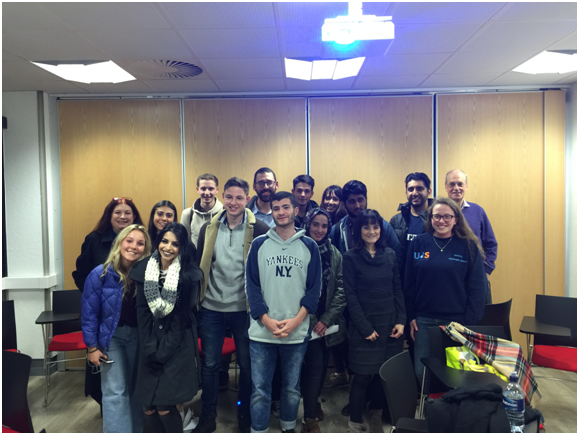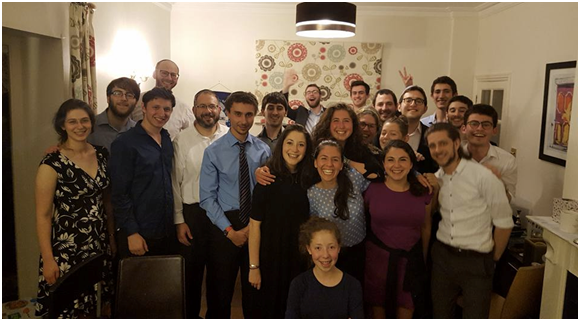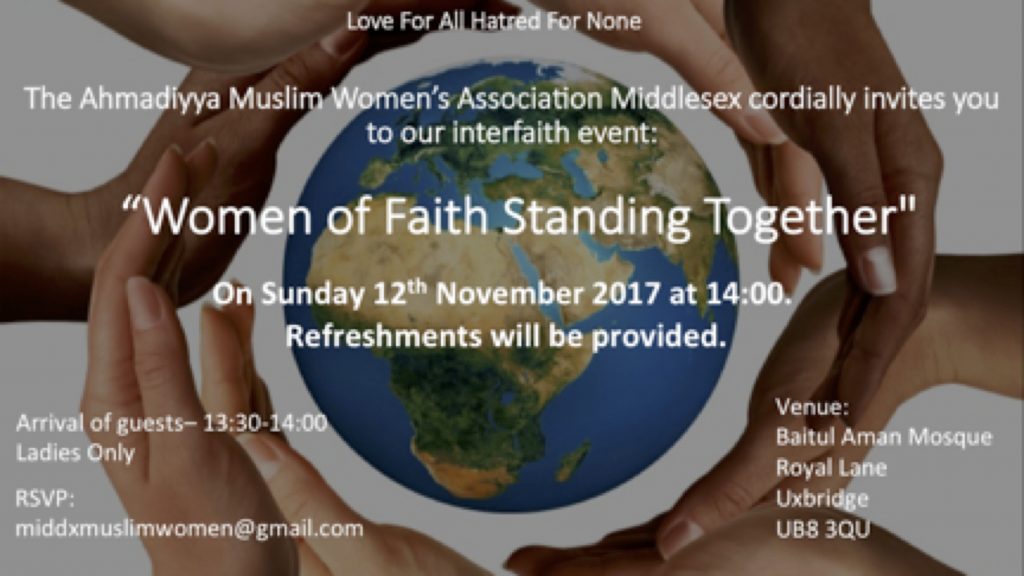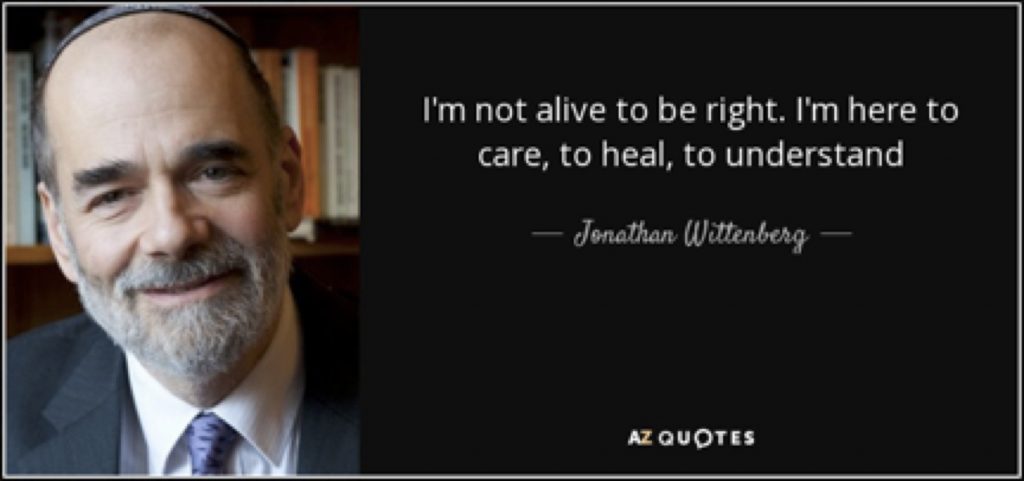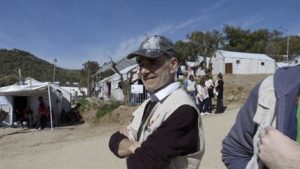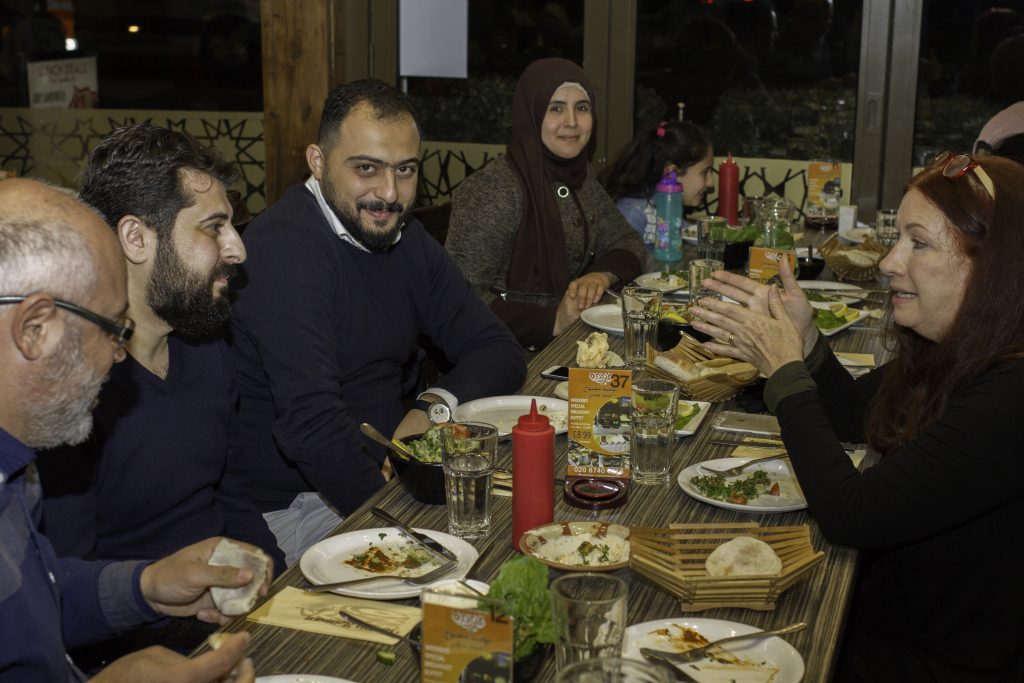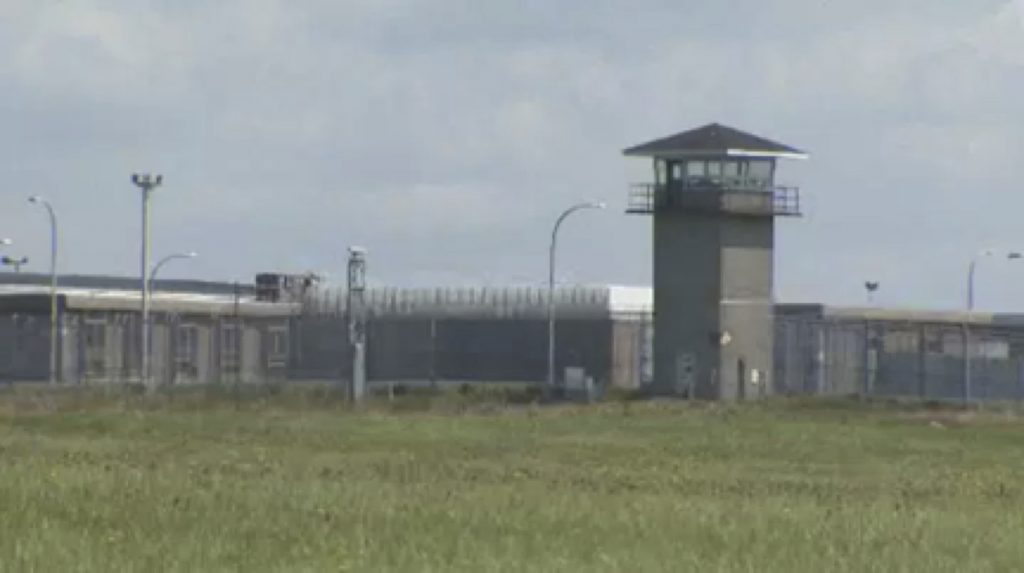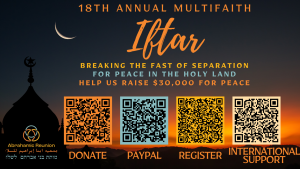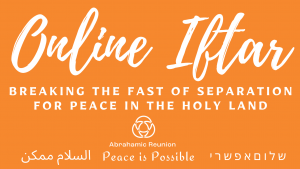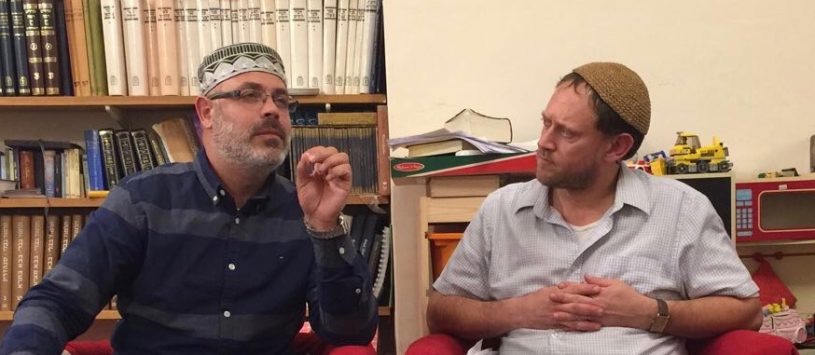
Sheikh Ghassan Manasra and Rev. Cherag Anna Less Phd travel to London and the UK for a late-autumn speaking tour which also includes National Interfaith Week in the UK. They are joined by Sheikh Ghassan’s daughter and AR young adult leader Zeynab Manasra, Rabbi Mordechai Zeller (trustee to AR UK and Rabbi in residence at Cambridge University), and Michael & Amanda Kenton, co-founders of AR UK.
The Abrahamic Reunion Travels to Bristol, England
Yesterday, Abrahamic International Director, Sheikh Ghassan Manasra, and Abrahamic Reunion Executive Director, Reverend Anna Less PhD, and Abrahamic Reunion Youth Leader Zaynab Manasra traveled together with Abrahamic Reunion UK co-founders Michael and Amanda Kenton to Bristol England, where we were the guest speakers at an interfaith event hosted by Bristol University’s Jewish Chaplain Rabbi Alex Tyskin
Each week Rabbi Alex hosts a Bristol Jewish Society (JSoc) group that offers Jewish (and non-Jewish) students the opportunity to socialize, celebrate Jewish festivals and enjoy Jewish culture.
Recently the group has begun exploring interfaith, and this week, Rabbi Alex has invited the Abrahamic Reunion to facilitate at a special event that he has prepared for his students, together with members of Bristol University’s Islamic Society (Isoc).
After traveling 2.5 hours by train and underground to Bristol we meet Rabbi Alex and grab a quick bite at a Kosher friendly, vegan falafel restaurant. As we walk through the cold damp evening to the campus, we begin to meet Jewish and Muslim students headed for our presentation.
After hearing that campus tensions between Muslim and Jewish students has been particularly high on many English campuses since the 100th anniversary of the Balfour Declaration on November 1st, I was a bit wary at first but these students, some wearing headscarves and others wearing kippahs and tzitzit, greet one another with genuine affection, so I begin to relax and breathe.
The 16 students at our event are very diverse. The Muslim students come from Somalia, Pakistan, Nigeria, various parts of the Middle East, and England. The Jewish students are from England and Israel.
First I present the Abrahamic Reunion power point then Ghassan speaks, alternating between English, Hebrew and Arabic.
We relax even more, and the students begin to ask questions. Several Jewish students share that they have recently returned from Israel, where some have stayed in settlements, and others have stayed on kibbutzim. They admit that it is so much easier to engage in interfaith here in England, where they feel safe.
One sensitive and beautiful young woman describes how Palestinian men and youth heckled her while she was in Israel, and other Jewish youth nod and agree. They confess that they were afraid, and fear made them predisposed to imagine the worst about “the other”.
We explained how the methods used by the Abrahamic Reunion actually make communities safer. We described how coming together and being seen in the protection of the community’s spiritual leaders and their congregations sends a powerful message that is absorbed by the entire community.
In many communities in America, Canada, England, Australia, and in Europe the Abrahamic Reunion’s work is deeply moving and life changing, but in many places in the world, where we help reduce community tensions the Abrahamic Reunion’s work can be life-saving.
We break into small groups to discuss the theme: “What can we as students do for Interfaith?” Ideas are exchanged, and debated, obstacles are considered, more ideas are discussed, and finally a spokesperson from each group describes their group’s idea for an interfaith project.
Ultimately 5 Jewish and Muslim students volunteer to start a monthly Abrahamic Reunion interfaith group in Bristol. Other students commit to participating and recruiting others. They promise to invite students of other faiths to their meetings.
There is a brief planning session. Emails and phone numbers are exchanged; Ghassan agrees to mentor the group by Zoom and pictures are taken.
As we pack up our things and prepare for the long journey home, we thank the students and Rabbi Alex for their support.
Rabbi Alex tells us that he searched for an organization, “like yours” when he was in Jerusalem and he couldn’t find one and he asks us to “Keep up the good work” and says “your work is so needed and so important.”
We also exchange big hugs with Michael and Amanda, because their dedication and hard work for the Abrahamic Reunion in England is really beginning to take root and grow.
These students, who come from such diverse backgrounds, have the profound responsibility, and the opportunity to influence future generations around world. Please support our work. Your contributions make it possible to spread our message of peace.
The Abrahamic Reunion at Oxford University
November 13, 2017
Today the Abrahamic Reunion’s Directors, Sheikh Ghassan Manasra and Reverend Anna Less PhD, travelled together to Oxford University with Abrahamic Reunion youth leader Zaynab Manasra and Abrahamic Reunion’s UK founders and Directors, Michael and Amanda Kenton, where they were the guests of honor at Rabbi Michael Rosenfeld-Schueler’s weekly scriptural reasoning group.
Scriptural Reasoning is a practice of inter-faith reading where people of all faiths gather and reflect on short passages from their scriptures together. It is a worldwide movement and Scriptural Reasoning ( www.scripturalreasoning.org) recently started happening in Oxford University.
At Oxford the Scriptural Reasoning Group meets on Mondays from 1:00 to 2:00 in the Harold Wilson Room of Jesus College.
The group spends time with texts from Jewish, Christian, and Muslim traditions, and discusses ancient, medieval, and modern interpretations of Scripture, modern day practices, which reflect these texts, and what they mean personally for individuals and faith communities.
Rabbi Michael Rosenfeld-Schueler helps lead it and a free, simple kosher lunch is also provided.
The topic of today’s discussion is: “The Soul.”
Spencer Klavin, a brilliant Oxford researcher and lecturer on ancient Greek philosophy and music, shares teachings from the Christian Scriptures and St. Thomas Aquinas, a philosopher and theologian from Italy (1225 –1274) who is regarded as one the most influential thinkers of medieval scholasticism.
Spencer first reads from the Christian scriptures in Greek and then translates Corinthians 2:9-16 into English.
However, as it is written:
“What no eye has seen,
what no ear has heard,
and what no human mind has conceived”
the things God has prepared for those who love him—
these are the things God has revealed to us by his Spirit.
The Spirit searches all things, even the deep things of God. For who knows a person’s thoughts except their own spirit within them? In the same way no one knows the thoughts of God except the Spirit of God. What we have received is not the spirit of the world, but the Spirit who is from God, so that we may understand what God has freely given us. This is what we speak, not in words taught to us by human wisdom, but in words taught by the Spirit, explaining spiritual realities with Spirit-taught words.[ The person without the Spirit does not accept the things that come from the Spirit of God, but considers them foolishness, and cannot understand them because they are discerned only through the Spirit. The person with the Spirit makes judgments about all things, but such a person is not subject to merely human judgments, for,
“Who has known the mind of the Lord
so as to instruct him?”[
But we have the mind of Christ.
Spencer goes through the typical English translation (above) of this passage, and in each place where the word “spirit” has been used, he refers back to the original Greek word that was used in the earliest Greek scriptures. And he explains that in many cases the early Greek scribes were using words that more closely correlated to the ancient Hebrew words for breath and soul. He rereads the passage substituting these words and the passage takes on even more life.
Then Rabbi Michael reads a passage from Genesis 2:7 which says:
“The Lord God formed man from the dust of the earth. He blew into his nostrils and man became a living being. “
After reading this passage Rabbi Michael points out that there is a difference between how man was created and how the rest of creation came into being. “The rest of creation,” he explains, “came into manifestation as the result of a command from God. The command was “ Let there be ….. Light … Water… Land … Sky… Creatures etc. and they became. “But,” he points out, “the human being is different” and he repeats,
“Man came into existence because God breathed his own breath into man.
Rabbi Michael explains further that according to the Zohar III:25a we find that “the Nefesh is bound to the Ruach, and the Ruach to is bound to the Neshama, and the Neshama to the Blessed Holy One.”
In the Zohar a soul is like a chain with one end linked into the brain and the other to a certain spiritual source. He explains that according to Judaism there are five levels of the soul and these levels are like five links in a chain, linking Man to God. He explains that each link in the chain is parallel to the spiritual sphere where it exists. However, we as human beings only relate to the three bottom links as we have no understanding about the two top ones. These three bottom links are 1) Nefesh 2) Ruach 3) Neshama. The Nefesh is the spiritual existence, which resides in the body and keeps the physical metabolism working, and the person alive. The Ruach is a connection between the Nefesh and the Neshama. It is the cause of feelings and personal qualities.
The Neshama is the spiritual existence that pulls the man towards God, to the performance of good deeds, to being pious and humble, and to seeking knowledge and achievement in spiritual fields. It resides around the head.
Rabbi Michael repeats:
“God formed man out of the dust of the earth, and He blew into his nostrils a breath of life.”
And he explains the analogy written about by Rabbi Aryeh Kaplan (1934 –1983), an American Orthodox rabbi and author known for his knowledge of physics and kabbalah, who used the analogy of blowing glass, which begins with the breath (Neshima) of the glassblower that flows as a wind (Ruach) through the glassblowing pipe and finally comes to rest (Nefesh) in the vessel that is being formed.
Rabbi Michael explains that the Neshama comes from the same root as Neshima, which means the breath of God.
And the Nefesh comes from a root meaning “to rest” and therefore refers to the part of the soul that is bound to the body and “rests” there. Ruach, which means a wind, refers to the part of the soul that binds the Neshama and Nefesh.
Rabbi Michael also points out that there is a link between the word Nefesh, which is often used to mean “person” or “living being” and the blood. He explains that, in the Torah, animals may also possess this life force: “Nefesh Behemah.”
A young Jewish man wearing a kippah and tzittzit in the group also comments that these passages from Genesis about the breath of God and the relationship of the breath of God to blood formed the basis for the development of kosher halakha (Jewish law).
After Rabbi Michael speaks, Ghassan speaks about Ibn al-`Arabi’s teachings regarding the soul. A contemporary of St. Thomas Aquinas who Spencer had talked about earlier, Ibn al-`Arabi (1165 -1240) was also known simply as Sheikh Al-Akbar, “the greatest master”. He was an Arab, an Andalusian, a Sunni scholar of Islam, as well as a Sufi mystic, poet, and philosopher, who was also regarded as a genuine saint.
According to Ibn Arabi the soul exists as the unifying force between man and God. Man can be understood to be a theomorphic continuation of God, and the path to understanding the soul is a path of self-discovery, as much as it is a path to know God. Ghassan explains that, according to Ibn Arabi the Essence of God, is revealed through knowledge of the Divine Attributes of God. According to Islam there are 99 attributes, or names for God, and these attributes, or qualities, exist within all human beings, and the purpose of our existence is to know these attributes and bring them into actualization. We do this through the use of the Imagination, which is the mediator between the Essential Reality of God and the World of Form. Through the Imagination we can interpret, and name the Qualities of God. And it is also through the Imagination that we come ever closer to God as a reality and engender that reality into our being.
According to Ibn al-`Arabi this process of knowing the soul takes place through the process of prayer. He explains that the path of the mystic is both a disintegration of one’s present interpretation of one’s self and a greater interpretive, imaginative realization of one’s being towards God. Ghassan explains that this alchemical process is continuous for the mystic, as well as for God.
After the meeting we help Rabbi Michael clear up the lunch and he jokes by sharing a Jewish saying: “Your physical needs are my spiritual needs.”
Members of the group eagerly seek out Ghassan and I; they express their appreciation for having all three Abrahamic Faiths represented at their Scriptural Reasoning event and share that they look forward to continuing a relationship the Abrahamic Reunion in the future.
We are grateful to have made these connections between the Abrahamic Reunion and these illustrious scholars from Oxford and we look forward to going back.
Women of Faith Stand Together
November 12, 2017
Today Abrahamic Reunion Youth Leader Zaynab Manasra and I, Reverend Anna Less PhD, The Abrahamic Reunion’s Executive Director, and Amanda Kenton, the Abrahamic Reunion’s UK Founder and Director, travelled to the Baitan Amul Mosque in Uxbridge, England to be guest presenters at an all-women’s event called ‘Women of Faith Standing Together.’ We, together with Rabbi Naomi Goldman from the Kol Chai Synagogue in Middlesex, England, are the guests of honor.
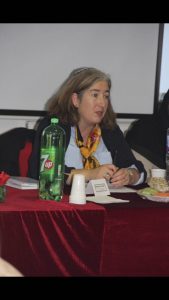 Rabbi Naomi is the newly appointed Rabbi at Kol Chai Synagogue, the spiritual home for about 300 Reform Jewish families. Reform Judaism is a major Jewish denomination that recognizes the evolving nature of Judaism, and emphasizes Judaism’s ethical aspects rather than its ceremonial ones. Considered to be a liberal strand of Judaism, Reform Judaism was formulated by Rabbi Abraham Geiger and his associates in 19th-century Germany.
Rabbi Naomi is the newly appointed Rabbi at Kol Chai Synagogue, the spiritual home for about 300 Reform Jewish families. Reform Judaism is a major Jewish denomination that recognizes the evolving nature of Judaism, and emphasizes Judaism’s ethical aspects rather than its ceremonial ones. Considered to be a liberal strand of Judaism, Reform Judaism was formulated by Rabbi Abraham Geiger and his associates in 19th-century Germany.
In the audience there were approximately 80 Muslim women and about 25 Jewish women; the Ahmadiyya Muslim Women’s Association of Middlesex, a subgroup from the Ahmadiyya Muslim Community in England, hosted the event.
The Ahmadiyya, whose motto is “Love for all. Hatred for none,” regard themselves as a moderate sect of Islam. Persecuted in their native homes of India and Pakistan, they have a large population in England and in the USA. Part of their belief is to understand other religions and to counteract extremism.
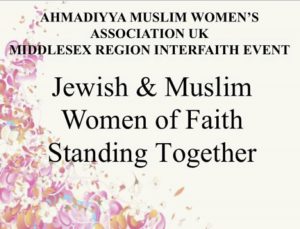 Established in the UK since 1913, The Ahmadiyya community built London’s first mosque, The London Mosque in Putney, in 1926. The Ahmadiyya Muslim community now has one hundred branches across Britain, and have opened a number of mosques, including the landmark Baitul Futuh mosque in south London, which holds 10,000 worshippers, and is the largest mosque in western Europe.
Established in the UK since 1913, The Ahmadiyya community built London’s first mosque, The London Mosque in Putney, in 1926. The Ahmadiyya Muslim community now has one hundred branches across Britain, and have opened a number of mosques, including the landmark Baitul Futuh mosque in south London, which holds 10,000 worshippers, and is the largest mosque in western Europe.
One of the 72 sects of Islam the Ahmadiyya are often persecuted for their beliefs by other Muslims primarily because the Ahmadi believe that their founder Mirza Ghulam Ahmad (1835 –1908) is the messiah and successor of the prophet of Muhammad.
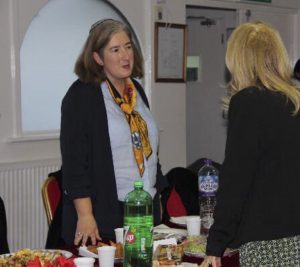 Rabbi Naomi presents first, and she reads passages from the Jewish tradition that emphasize Judaism’s commitment to friendship, and support for other religions.
Rabbi Naomi presents first, and she reads passages from the Jewish tradition that emphasize Judaism’s commitment to friendship, and support for other religions.
First she tells the Talmudic story that is often attributed to Hillel the Elder (c. 110 BC – 10 AD) in the following teaching Hillel, who is asked by a prospective convert to Judaism, to teach him the whole Torah while he stands on one leg, replies:
“Don’t do unto others what you would not want done to you – that is the whole Torah; the rest is commentary”
Rabbi Naomi also promises Jewish friendship and support for the Muslim community, and reads the following Jewish teaching regarding how Jewish people are required to treat foreigners.
Love foreigners as you love yourselves, because you were foreigners one time in Egypt. I am the Lord your God.”
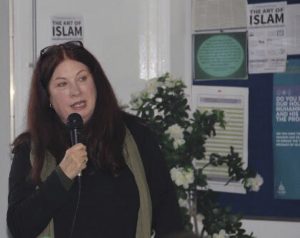 After Rabbi Naomi’s presentation, I give the Abrahamic Reunion’s Power Point Presentation, which describes how we put the AR’s founding precepts into action through various projects.
After Rabbi Naomi’s presentation, I give the Abrahamic Reunion’s Power Point Presentation, which describes how we put the AR’s founding precepts into action through various projects.
After the AR’s presentation, a number of women from the Ahmadiyya community speak, explaining their teachings and ideals
Then there is a question and answer period, and members of the audience who were clearly inspired by the AR’s simple, yet innovative interfaith projects ask many questions about the practicalities of adapting these methods to expand their own interfaith efforts.
They are particularly interested when Zaynab describes a project she participated in that was initiated by the Abrahamic Reunion when she was a young teenager. Zaynab described how in Israel, where she grew up, communities are often isolated by religion, and therefore most schools are home to students of only one religion. In this environment a young Zaynab had developed an attitude that her religion was the “best religion” and the only “true religion.” But then she participated in a three-day Abrahamic Reunion project that brought students from the Muslim, Christian, Jewish and Druze faiths, to live together for three days under the supervision of their teachers. These students spent these three days eating together, sleeping together, and discussing open-ended questions, and participating in activities designed to transform their preconceived attitudes about “the other.”
Zaynab described the project as completely life altering, it was a 3 day experience that forever opened her heart and changed her attitude about other religions.
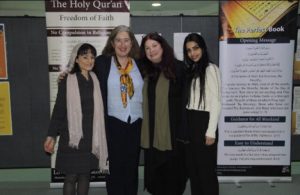 Ten years later, Zaynab remains in touch with students from this project; she says now a number of those students have children of their own and as young parents they dream of repeating the project with their own children in a few years.
Ten years later, Zaynab remains in touch with students from this project; she says now a number of those students have children of their own and as young parents they dream of repeating the project with their own children in a few years.
We tell the members of the Ahmadiyya community, and the Jewish community that if they are interested in becoming trained as an interfaith project developer that the AR is available to mentor them or simply answer questions and offer support.
After watching our slide show and asking questions, women in the audience become inspired, begin to brainstorm and spontaneously discuss innovative interfaith project ideas of their own.
I ride home with Mrs Lubna (Navida) Ahmad, the Regional Secretary for the Ahmadiyya Muslim Women’s Association Middlesex, and it feels like the AR has found a friend in a community dedicated to the same ideals for peace and interfaith.
Dinner With Rabbi Wittenberg and Members of the Jewish Community in London
November 10, 2017
Rabbi Jonathon Wittenberg is Masorti Judaism’s senior rabbi in the UK. He is also the Rabbi of the New North London Synagogue, which has approximately 2400 members. Besides being a leading writer and thinker on Judaism, he is also a board member of the Elijah Interfaith Institute, an organization that partners with the Abrahamic Reunion and Tantur Institute, to co-sponsor “Praying Together In Jerusalem”, a monthly event whose participants believe in the power of side-by-side prayer to bring friendship, respect and, ultimately, peace between people of all faiths. These gatherings have been held at various venues within, and outside the walls of the Old City of Jerusalem since 2015. They are currently held on the last Thursday of every month, at sunset, at the Jaffa Gate.
For more information you can contact Abrahamic Reunion Board Member, Raanan Mallek: raanan.mallek@gmail.com
Rabbi Wittenberg and his congregation together with a few other congregations have collectively taken on the responsibility of supporting a community of Syrian Refugees in their North London district of Finchly, and it was at his home, last spring that the Abrahamic Reunion was invited to co-host an interfaith Iftar for those refugees, and the congregations that support them. To this day we have still maintained a close relationship with the Syrian families we met there.
The depth of Jonathon Wittenberg’s commitment to these refugee families and to interfaith can best be described in his own blog, which begins like this:
Refugees from Nazi Germany, new to London, twice bombed out in 1940, my mother and her family were taken in by a devout Christian couple, the Micklems. These good people welcomed them into their home in Boxmoor, where they stayed until the end of the war.
When they were leaving, my mother said to Mrs Micklem:
How can I ever thank you enough?
She answered:
One day you’ll help others who are refugees as you once were. That’s how you’ll thank us.
(To read more: http://jonathanwittenberg.org/community/an-impassioned-plea-for-refugees/)
This time we have been invited to Rabbi Wittenberg’s home to help him commemorate, together with members of his large congregation, the event described in Genesis of when Isaac and Ishmael come together to bury their father, Abraham.
Then Abraham breathed his last and died at a good old age, an old man and full of years; and he was gathered to his people. His sons Isaac and Ishmael buried him in the cave of Machpelah near Mamre, in the field of Ephron, son of Zohar the Hittite, in the field Abraham had bought from the Hittites. There Abraham was buried with his wife Sarah.
Genesis 25:8-10
The story is profound in its simplicity: Isaac and Ishmael, half-brothers who earlier did not get along, come together in peace to bury their father. It’s an amazing story of forgiveness that I think still says a lot to us today.
It is Shabbat so no photographs are allowed, but I have included some stock photos of Rabbi Wittenberg that convey his deeply compassionate nature.
We meet many influential members of the Jewish community in Rabbi Wittenberg’s home. Most of them hail from all over the world, and have fascinating backgrounds.
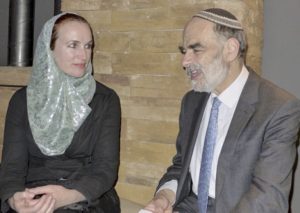 One older woman, Judith, explains that her family came from Aleppo, Syria but she was born and raised in Jerusalem and although she is Jewish, her first language was Arabic, “because at that time almost all of the Jews in my generation who lived in Jerusalem spoke Arabic as their first language.”
One older woman, Judith, explains that her family came from Aleppo, Syria but she was born and raised in Jerusalem and although she is Jewish, her first language was Arabic, “because at that time almost all of the Jews in my generation who lived in Jerusalem spoke Arabic as their first language.”
I was also surprised to learn that Judith’s brothers and sisters had Arabic names rather than Jewish names. “It didn’t used to be like it is now,” she says, “in those days we all lived together, we spoke Arabic, we were neighbors, and we were friends.”
I am in awe of this woman, who although she is 88 years old, is still a practicing psychotherapist who travels to the West Bank and Israel regularly to train and mentor psychotherapists there. She founded, and is the chair of an organization in the UK called the “Friends of the Bereaved Familes’ Forum”, a group that supports 600 Israeli and Palestinian families who have lost close relatives to inter-communal violence, and are determined to spare others what they have suffered.
The next day, for Interfaith Week, Judith will be speaking to the congregation of a large mosque in London to represent the Jewish community, and the perspective of the “Friends of the Bereaved Familes’ Forum.”
We were also happy to meet Liron Velleman again. Liron is the Campaign’s Manager for the Union of Jewish Students. (UJS), which represents 85,000 Jewish students on campuses across the UK and Ireland. Last year we met Liron at an Abrahamic Reunion event he help organize for students, at the Jewish Community Centre in London.
Another gentleman seeks us out, and takes our card and says he is anxious to connect, because he was the psychotherapist who trained the therapists at Grendon Prison, where he knows The Abrahamic Reunion has been working. He wants to support our prison work and we are eager to follow up.
Other important connections are made, and since that evening a number of participants, who took our cards, have reached out to connect.
Thank you Rabbi Wittenberg for supporting our work. We look forward to being together again soon.
Dear readers, your donations have enabled us to expand the Abrahamic Reunion’s support network in the UK, where our work is rapidly growing. Please continue to support us and donate to the Abrahamic Reunion.
Rabbi Wittenberg visiting Syrian Refugee camp in Greece.
The Zohar, Interreligious Text Study at Cambridge University with Rabbi Mordechai Zeller, and Ibn Arabi
Today we traveled to Cambridge to meet with Abrahamic Reunion Peacemaker Rabbi Mordechai Zellar who is currently the Jewish Chaplain at Cambridge University. It is interfaith week in England, and Mordechai has invited the Abrahamic Reunion, and the Cambridge University Islamic Society (Isoc) to his weekly Zohar study group.
The word Zohar means “splendor” or “radiance” and it is considered to be the core text of Jewish mystical thought known as Kabbalah, which offers a mystical interpretation of the Bible.
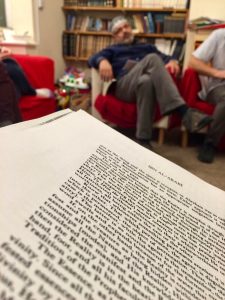 Composed by kabbalist Rav Shimon bar Yochai, the Zohar is a set of twenty-three books that provide a commentary on biblical and spiritual matters in the form of conversations among spiritual masters. On the one hand it is a vast, comprehensive commentary on biblical matters, and on the other hand it is intended to be a guidebook for the lost divine nature of our souls, and the Zohar describes all of the spiritual states that the sole experiences as it evolves. At the end of this process, the soul achieves what Kabbalah refers to as “the end of correction,” the highest level of spiritual wholeness.
Composed by kabbalist Rav Shimon bar Yochai, the Zohar is a set of twenty-three books that provide a commentary on biblical and spiritual matters in the form of conversations among spiritual masters. On the one hand it is a vast, comprehensive commentary on biblical matters, and on the other hand it is intended to be a guidebook for the lost divine nature of our souls, and the Zohar describes all of the spiritual states that the sole experiences as it evolves. At the end of this process, the soul achieves what Kabbalah refers to as “the end of correction,” the highest level of spiritual wholeness.
Often written as a cipher, the codes, metaphors, and cryptic language of the Zohar are designed to provide channels for spiritual energy.
Hidden for 900 years between the 2nd and 11th centuries, the Zohar began to be shared in the 16th century when The Holy Ari, Rabbi Isaac Luria (1534-1572) stated that from his time onward, the wisdom of Kabbalah was ready to be opened to everyone.
The topic of today’s interfaith study group will be the relationship between Abraham and his nephew Lot from the perspective of Judaism, and Islam.
Mordechai, Ghassan and I have had a few conference calls to prepare for this evening. When Ghassan mentions to Mordechai that he would like to use Ibn Arabi’s book “The Bezels of Wisdom” as his source for speaking about Abraham, Mordechai not only runs out to get Ghassan a current copy of the book from the store, he makes arrangements for us to visit Cambridge University’s research library to study some of the earliest known copies of this precious book.
Called by Muslims “the greatest master,” Ibn Arabi was a Sufi born in twelfth-century Spain. At the end of his life, while in Damascus Ibn Arabi had a vision that prompted him to write this book. He describes the experience in his preface.
“I saw the Apostle of God in a visitation…He had in his hand a book, and he said to me, “This is the book, “The Bezels of Wisdom”, take it and bring it to men that they might benefit from it.”
A “Bezel” is a setting on a ring, and in Arab culture this “Bezal” would have been set with a gem, engraved with the wearer’s name, to make the ring into a seal.
The “setting” that holds Ibn Arabi’s gem of spiritual wisdom, describes the author’s mystical insights through the lives of each of the prophets, and Ghassan wants to share with our group Ibn Arabi’s esoteric commentaries on the life of Abraham.
As we walk on cobblestone streets, through Cambridge’s medieval neighborhoods, we feel as though we have already begun a journey back in time.
Outside the Cambridge Library Itai Kagen, the son of Rabbi Ruth Kagen and Michael Kagan, who have participated in many Abrahamic Reunion events in Israel, comes running up to us to embrace Ghassan. Visiting from Hebrew University, Itai is living in London to do Biblical research. He has heard that Ghassan will be teaching with Mordechai in Cambridge, and has traveled with his wife 2 hours by train to attend Mordechai’s Zohar class so he can hear Mordechai and Ghassan teach together. While we use the library’s research room to study Ibn Al’ Arabi, he will be here to study an ancient Hebrew manuscript found in Egypt.
We enter the library bearing 2 forms of ID. Security is tighter here than at the prison we had entered together two days earlier.
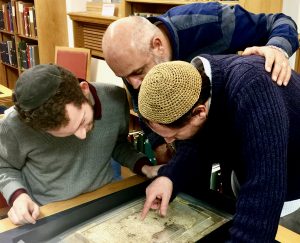
We are escorted through a series of locked doors that require pass codes, to a room containing Cambridge University’s most valuable and precious books. Photos are forbidden as two ancient volumes are offered to us on pillows. Only one person, Estara, the research specialist has permission to touch the books, and turn the pages, which have been mounted on special paper to preserve them. One book was composed in the 14 century, and the other one was written in the 16 century. Several different scribes hand wrote each volume, as Estara points out where the script of each different scribe changes. We hover around Estara, as she turns the pages, and Ghassan begins to read out loud when he comes to the section on Abraham. Certain pages contain blank symbols in the midst of the hand written script. Ghassan explains these esoteric symbols are ciphers and amulets used to transmit realization and messages to the reader. The margins of the pages contain hand written notes in Arabic, Hebrew, and other ancient languages, the work of long ago scholars deciphering the esoteric contents for their own research.
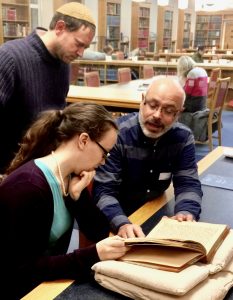 Ghassan reads aloud to us and translates as he goes along. The whole experience has a mystical quality so different than reading on the Internet, or from a modern mass-produced book. And we are mesmerized by the experience.
Ghassan reads aloud to us and translates as he goes along. The whole experience has a mystical quality so different than reading on the Internet, or from a modern mass-produced book. And we are mesmerized by the experience.
We also take time to visit Itai at the table behind us, as he carefully sifts through the fragments of an ancient Hebrew manuscript that have been suspended between large sheets of plastic. He and Mordechai and Ghassan read it together and Itai explains that he can speak at least eleven ancient biblical languages, and he is here to do research for his professors at Hebrew University. He says he and Estara will meet us later at Mordchai’s Zohar class.
As we gather for our meeting about 25 people enter the room. As they introduce themselves I am quick to realize that this text study group is not going to be like any text study group I have attended before. This will be a meeting of biblical scholars. Although many are still students most are postgraduates doing advanced biblical study.
Mordechai begins by telling the story of Abraham and Lot’s relationship, in a historical context, then Mordechai begins to use the Zohar to peel back the outer layers of the story and interpret the symbology and metaphors it contains to reveal the story’s luminous esoteric core
After Mordechai speaks, Ghassan begins to share Ibn Arabi’s spiritual interpretation of these stories.
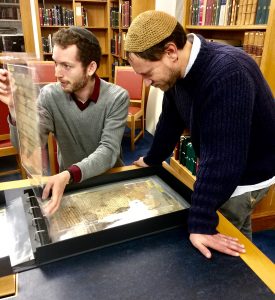 I am stunned by the similarities and I wonder what is the connection between these two authors? What journeys have transpired, and what exchange of knowledge has taken place to inform these two great works? Surly the influences must be there. The similarities are obvious to everyone, and the scholars offer informed speculations, that may have transpired, and identify scholarly connections within and between these two spiritual lineages.
I am stunned by the similarities and I wonder what is the connection between these two authors? What journeys have transpired, and what exchange of knowledge has taken place to inform these two great works? Surly the influences must be there. The similarities are obvious to everyone, and the scholars offer informed speculations, that may have transpired, and identify scholarly connections within and between these two spiritual lineages.
I have participated in many text study groups before, but I have never experienced such a profound, spiritual state as I have had in this text study group, I am left with a luminous sense of awe, and a powerful sense of spiritual truth as I listen to these two interpretations.
I feel grateful that the enlightened spiritual leaders in the Abrahmic Reunion such as Sheikh Ghassan Mansara and Rabbi Mordechai Zellar, are able to guide participants in these text study programs to break through the academic shell that can imprison the spiritual experience that the authors intended their readers to have.
If you are interested in learning how to start an Abrahamic Reunion text study chapter please contact Anna Less, the Executive Director of the Abrahamic Reunion, at anna@abrahamicreunion.org
Dinner with Syrian Refugees in London
November 8, 2017
A number of you may have read my blogs from May about our visit with Alaa and his family, who are refugees from Syria living in London. I have recopied those blogs from May here to provide you with a back ground for today’s story.
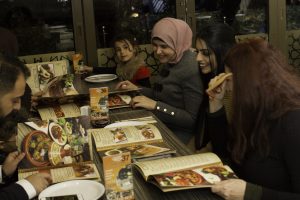
Ghassan and I have stayed in touch with Alaa since May and we have learned that his brother Bahaa finally gained permission in June to move to England and join them. After two years separation, he has been reunited with his wife and children and has been living here and adapting to life in England. We are anxious to meet him and also to learn how Alaa is doing.
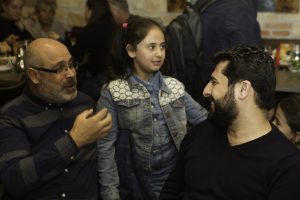 Of the many people we met on our last journey Alaa was perhaps the most enthusiastic person we had encountered. He expressed a great desire to learn to become an Abrahamic Reunion facilitator for interfaith text study groups. He saw it as a great method for helping the mostly Muslim Syrian Refugee community in which he is clearly a leader, to practice their English, and learn about the culture and beliefs of the English community they had now become members of.
Of the many people we met on our last journey Alaa was perhaps the most enthusiastic person we had encountered. He expressed a great desire to learn to become an Abrahamic Reunion facilitator for interfaith text study groups. He saw it as a great method for helping the mostly Muslim Syrian Refugee community in which he is clearly a leader, to practice their English, and learn about the culture and beliefs of the English community they had now become members of.
A few months ago these dreams crumbled when we were heartbroken to learn that in August, just as Alaa had finally gained permission to work in England, he was diagnosed with colon cancer, and since then he has had his entire colon removed, and is currently in his third round of chemotherapy. It seemed that things had suddenly taken such a dire and unexpected turn for this young family, who a few months ago seemed on the verge of beginning a hopeful new life.
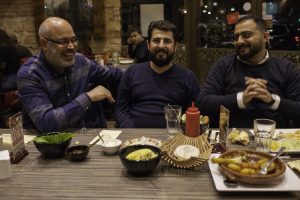 We have invited Alaa and his wife Taghrid and their daughter Yara as well as Alaa’s brother Bahaa and his wife and their two children to a nearby Syrian restaurant for dinner. They have told us that since leaving Syria over three years ago they have not been able to afford to go out to eat in a restaurant so we hoped this will be a special occasion for them.
We have invited Alaa and his wife Taghrid and their daughter Yara as well as Alaa’s brother Bahaa and his wife and their two children to a nearby Syrian restaurant for dinner. They have told us that since leaving Syria over three years ago they have not been able to afford to go out to eat in a restaurant so we hoped this will be a special occasion for them.
The neighborhood where we stay in London is mostly inhabited by people from the Middle East. The grocery stores and restaurants advertise halal meat and feature foods common to that region of the world. The signs and menus are written in Arabic, and the staff is able to communicate with shoppers and diners in their native language. Women are typically dressed in full niqabs or hijabs. At times it is hard to remember we are in England, because it feels more like we are in a Middle Eastern country. We hope they will feel at home.
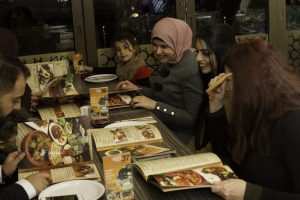
We are surprised when Alaa walks into the restaurant. He has a long beard and a full head of hair. He looks well, except for a sadness in his eyes. He explains that due to his low immune system doctors do not allow him to shave. We sit down to eat and they seem delighted to discuss the menu with the wait-staff in Arabic. The staff, who know us, and why we are here, are anxious to serve this family with love and kindness and treat them with special care.
It feels like a holiday and Alaa shyly shares, that tomorrow it is their one-year anniversary since arriving in England. As the evening continues he again expresses his desire to begin text study group for his community, but it is evident that his health is fragile and soon he appears very tired.
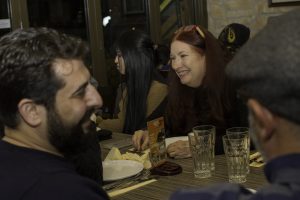 We take a short walk and they all express that they look forward to revisiting this neighborhood again soon as it is so comforting to be in a place that feels like home.
We take a short walk and they all express that they look forward to revisiting this neighborhood again soon as it is so comforting to be in a place that feels like home.
We stop on the sidewalk, to call an Uber and look up and see a big sign that says: “No one ever really dies.” Alaa walks over and takes a picture. It is a poignant moment as this young family considers their uncertain future.
Opening Hearts at Springfield Prison
November 7, 2017,
Today Abrahamic Reunion’s UK tour had a presentation at Springhill Prison in Buckinghamshire, England.
Abrahamic Reunion Peacemakers Sheikh Ghassan Manasra (Director), Rabbi Mordechai
Zeller (a former resident of Israel serving as the current Rabbi for Cambridge University, and a trustee for the Abrahamic Reunion in the UK), and I, Reverend Cherag Anna Less PhD, (AR Executive Director) together with Abrahamic Reunion youth leader, Zaynab Manasra, and our UK Abrahamic Reunion team, Michael and Amanda Kenton, and Yvonne Dixon the Quaker Chaplain at Springhill Prison, met to offer a presentation to approximately 80 inmates, staff members and chaplains at Springhill Prison.
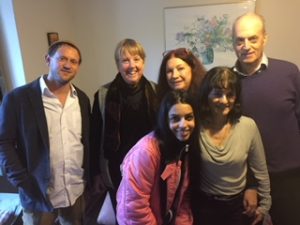
No photos were allowed in the prison, however this photo was taken beforehand of everyone going (minus Sheikh Ghassan who is taking this picture.)
Yvonne introduced us to the audience and spoke about Springhill’s history, which served as the training centre for British Special Forces during World War II. She explained that the gymnasium where we were giving our presentation was built by the prisoners and named after Britain’s first Muslim war heroine, Noor-un-Nisa Inayat Khan.
Although Springhill Prison shares the same grounds as Grendon Prison, where the Abrahamic Reunion had presented last year, Springhill has a very different population than Grendon Prison, which offers a therapeutic program for England’s most dangerous and violent criminals.
Springhill is an open prison that supports the needs of about 335 long-term prisoners who are in the last few years of their sentence. At Springhill prisoners train and prepare for their release, and participate in a resettlement program that allows them to work in jobs outside of the prison during daylight hours, and return to live in the prison when they are not working.
The majority of residents in our audience were Muslims and surprisingly for us, there were a number of Palestinians.
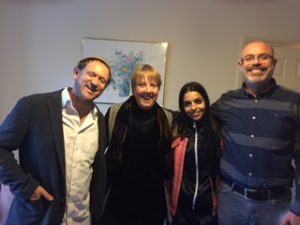
The Palestinians inmates eagerly gathered around Ghassan to speak with him in urgent, hushed Arabic while Mordechai and I made our presentations.
After all of us had spoken there was a Question and Answer period, and initially the tone of the inmate’s “questions”, which were directed at Mordechai, began as wounded and skeptical challenges that bordered on being aggressive.
But Ghassan immediately stepped in to skillfully navigate their hostility, and soothe them with quotes from the Quran and the Hadith.
He appealed to their innate desire for peace in ways that were culturally familiar for them, and once they felt their pain had been heard and responded to, they began to soften and calm down.
As Ghassan continued to raise their consciousness to a higher level, they reluctantly began to open their hearts to Mordechai (their preconceived enemy), and me (Mordechai’s naïve American accomplice, who didn’t understand their collective Muslim and Palestinian pain), and an atmosphere of trust, hope and camaraderie began to take over.
By the time the evening was winding down the inmates were asking, “Are there more people like you?” “Are there more people who believe
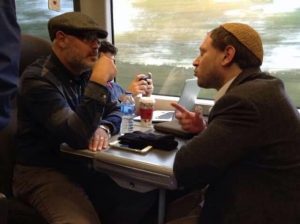
Sheikh Ghassan and Rabbi Mordechai prepare on the train to Springhill prison
what you believe?” In other words, “Is it really safe, and possible, to love one another?” As they hugged Ghassan and Mordechai goodbye, and shook my hand, they admitted what “a good guy” Mordechai was, and they shared that they had never met people like us, and this evening offered them the possibility to consider a new ending to an old story that always left them feeling like the victim. They asked how they could get in touch with us when they “get out.”
The authorities and staff at Springhill also immediately came forward at the end of the program to discuss our next steps together regarding offering programs, and in-depth trainings, here, and in other prisons they are responsible for.
As we packed our things to leave, we could finally exhale and thank the dedicated staff at Springhill. We send a special thanks to Chaplain Coordinator Brenda Davies and Yvonne Dixon for their support of the Abrahamic Reunion.

